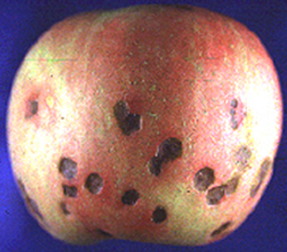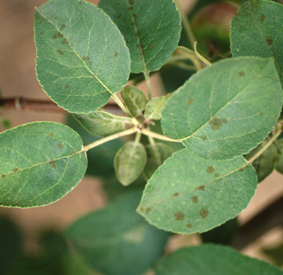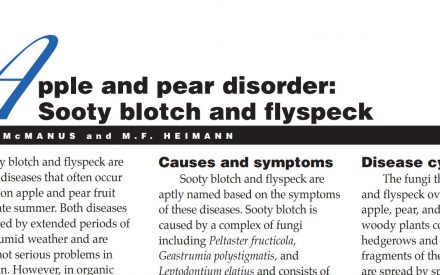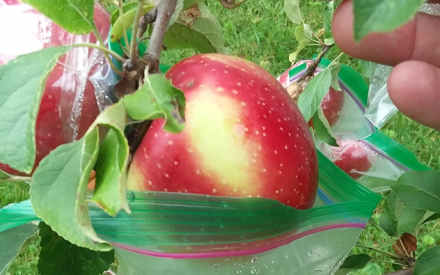
Bitter pit and cork spot are common disorders of Wisconsin apples. These two disorders do not occur every year, but when weather conditions are just right (or just wrong, depending on your perspective), they can be major problems. This fact sheet describes the causes of the disorders and what can be done to reduce the severity of the problems.
The name bitter pit will be used for both cork spot and bitter pit since they are related disorders. Bitter pit shows as brownish spots in the fruit flesh. The spots actually occur in the outer layers of the fruit but are visible through the skin. Bitter pit may develop before or after harvest. Cork spot develops before harvest. The flesh layers underlying the skin collapse, become brown and take on a “corky” appearance. The exact underlying cause of these disorders is not known, however, they are both known to be calcium related.
Several factors are associated with development of bitter pit.
High tree vigor
Trees that are invigorated by heavy pruning, light crops, or nitrogen applications beyond sufficient ranges have a higher incidence of bitter pit. Pruning is vegetatively invigorating and trees that are heavily pruned will also have light crops and substantial vegetative growth. High nitrogen fertilizer doses also lead to substantial vegetative growth. Vegetative growth competes with fruit for available calcium. If calcium is shunted to vegetative growth, it is not available for fruit growth. Further, since calcium moves with water in the transpiration stream, greater leaf area will shunt more water (and calcium) to the leaves rather than fruit.
Moisture stress
Trees that have received either too much or too little water are more prone to bitter pit. The typical situation is too little water. Related to moisture stress is high temperature. Hot days lead to greater evapotranspiration from leaves. Calcium moves in the xylem along with the water that “feeds” the transpiration needs and ends up in leaves rather than fruit. Once in the leaves, calcium is immobile and will not move back to fruit.
Large fruit
Large fruit are more generally more susceptible to bitter pit than smaller fruit. A light crop will not only lead to vegetative vigor, but also to larger fruit and these fruit are more likely to show bitter pit.
To reduce the incidence of bitter pit in apples:
Provide irrigation
Most years, irrigation is not critical in Wisconsin and the cost of irrigation can be high. During dry spells or drought years, however, irrigation is very valuable for maintaining soil moisture levels and reducing tree stress.
Apply calcium sprays
Since calcium is immobile in plants once it has reached its destination, it is good practice to apply calcium to a tree so that some will end up on the fruit and be absorbed through the cuticle. You can use either calcium nitrate or calcium chloride, but calcium chloride is far cheaper. An additional downside to calcium nitrate is that it aggravates the “too much vigor” problem. Use four pounds of calcium chloride per acre, beginning with the first cover spray through late July. Then increase the calcium chloride rate to 6 lbs. per acre. For small orchards, this is equivalent to approximately 6 oz. of calcium chloride per gallon. During prolonged dry weather, eliminate calcium chloride applications to prevent buildup on the foliage and fruit that may cause burning. Do not make another application unless it has rained since the previous application. There are different calcium chloride products. Research in several states has shown that all products are equally effective if applied at the same rate of calcium, so use the cheapest option.
Include calcium in postharvest dip tanks or wash water
Michigan research has shown that a 4% dip or drench of calcium chloride will reduce the incidence or delay development of bitter pit in storage. Mix the solution as 33 pounds of calcium chloride per 100 gallons of water. After storage, fruits must be washed again to remove the calcium deposits.
Remember that calcium chloride is corrosive to metal so be sure to clean all equipment thoroughly after using calcium chloride. Painting and upkeep becomes even more important if calcium chloride is used.
I wish there were some “magic bullet” that would reduce the incidence and severity of bitter pit. Unfortunately, the problem is weather related and has several variables that determine its severity and incidence. In general, techniques that keep vigor under control and maintain a reasonable crop load (to keep competing calcium sinks from accumulating calcium that should go to fruit), coupled with applying calcium in cover sprays and at post harvest will help reduce the problem. There are no easy solutions.
For more information on bitter pit and cork spot:
Contact the University of Wisconsin Plant Disease Diagnostics Clinic (PDDC) at (608) 262-2863 or pddc@wisc.edu.
Authors: Teryl Roper, UW-Madison, Department of Horticulture
Last Revised: 02/28/2024
D-number: D0017
A complete inventory of UW Plant Disease Facts is available at the University of Wisconsin-Madison Plant Disease Diagnostics Clinic website: https://pddc.wisc.edu.
Send a Plant Sample for Analysis
Be cautious when self-diagnosing plant health issues. Very few diseases can accurately be diagnosed by eye.
Contact the UW Plant Disease Diagnostics Clinic (PDDC), and for a small fee, clinic staff can examine a plant, determine the cause of the disease/disorder, and provide advice on how to control or prevent the issue.
Download Article





 Apple Pest Management for Home Gardeners
Apple Pest Management for Home Gardeners Apple Scab
Apple Scab Apple Disorder: Sooty Blotch and Flyspeck
Apple Disorder: Sooty Blotch and Flyspeck Bagging Apples for Insect and Disease Control
Bagging Apples for Insect and Disease Control


